A program for connecting an IP camera to a computer. Review of Chinese WI-FI camera.
In order to properly connect an IP camera, you must have basic knowledge of local area networks(LAN). One of the main criteria for a LAN is the protocol for transmitting the video signal. For each network equipment (from different companies) and software use different protocols. Therefore they may not match. Before purchasing or connecting the system, make sure that they are compatible (whether the camera is suitable for the DVR or router).
The most important part of setting up an IP CCTV system is address. If configured incorrectly, it may complicate access to the system.
Setting up an IP camera connection
To configure the IP address, you need to connect the camera using twisted pair ( LAN cable) and power to your computer or laptop. If you plan to create a video surveillance system using several video cameras or plan to use them through a home router, then it makes sense to connect them simultaneously. To do this, it is recommended to use a special switch ( router). Otherwise, each device will have to be configured separately.
After connecting the camera, you can proceed to setting the IP address on your computer. In order to do this as quickly as possible, you need to go to the manufacturer’s official website, download and install a special software to configure it.
Depending on the manufacturer, the program interface for setting up an IP camera will differ, but the functionality will be approximately the same. We will look at connecting a camera using software as an example iVMS-4200 companies Hikvision. IP cameras from this manufacturer can be connected remotely using the service HiDDNS without using a static IP address.
Automatic connection
The IP address is configured in the following sequence:
- Launch the program and select the menu item Tool->Device Management;
- Select the " Server»;
- Click on the menu item “ Encoding Device»;
- In chapter " Online Device"A list of equipment connected to the network will appear, from which you can select equipment to operate using the " Add to Client»;
- If you know the device's IP, you can add the device manually by clicking " Add Device».

IP detection via client software
Manual connection
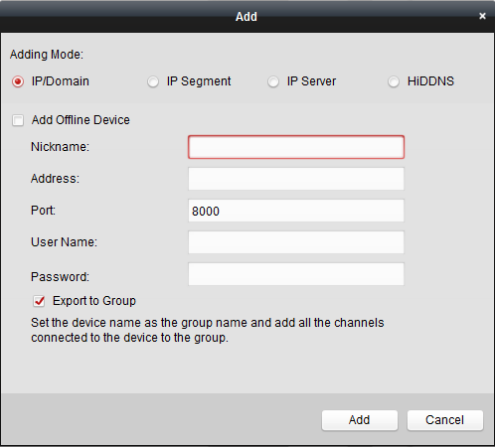
Remote connection via HiDDNS
It is often necessary to connect an IP camera remotely, that is, via the Internet. In this case, the IP address of the camera will constantly change, unless you specifically order a static IP address from your provider, for which an additional fee is always charged.
If you do not want to incur additional costs, you can use the free HiDDNS service.

Here you can also configure microphone parameters if you plan to record audio. This completes the IP camera setup. If you are using cameras from the same manufacturer, their addresses will be the same.
In order for the cameras to work correctly at the same time, each device needs to be assigned its own address.
How to change IP
By default, the penultimate digit of the IP address is one. This value must be changed to “0” for all cameras. And also change the penultimate digit in the gateway address (GateWay) to “0”. If the program does not have a line where it can be changed, then we change only the IP.
The last digits of the IP address must be different. Otherwise, the equipment will conflict and you will not be able to access them. We leave the first two values the same.
Change IP is possible not only using special software, but also through web interface. In this case, each will have to be configured separately. To get into it and change the camera address, necessary:



All data for logging into the web interface (login, password, IP) can be found in the device instructions (supplied, an additional copy of the documentation can be found on the manufacturer’s official website in the appropriate section).
Connecting to a DVR
The next stage of preparing the IP camera is setting up and connecting to a network video recorder or NVR(Network Video Recorder). The first thing to do is install to a video server for IP cameras HDD, if there is no built-in.
A regular one will do for this. SATA, which is connected to a laptop or computer (check the instructions for more detailed compatibility parameters). Procedure will be like this:
- Remove the back cover DVR;
- Find the connectors to connect hard drive, nutrition and others;
- Connect all the necessary wires, screw the HDD bolts to the bottom of the DVR;
- Replace the cover.

After installing the hard drive, you can start connecting IP cameras to the DVR. Depending on its features, the number and types of available connectors will vary. Usually this:
- Multiple video inputs (VIDEO IN) and one video output (VIDEO OUT);
- One audio input/output (AUDIO IN/OUT);
- Multiple USB ports;
- Internet cable connector;
- VGA port;
- Power cord.

If you plan to record not only the image, but also the sound, make sure that there is a built-in microphone or a connector for its connection on the camera, a corresponding port on the recorder.
Setting up the recorder
Connect all plugs to the recorder in series. Then connect the IP video cameras, external monitor and turn on the power supply. After this, you can begin further configuration. All your actions will be displayed on the monitor. For more comfortable navigation and interface control, connect a regular USB mouse from your computer to the recorder. Do the following actions in the web interface:


Other cameras are connected in the same way.
Attention! Never connect multiple cameras to the same channel.
Connecting a microphone
As a rule, the quality of the built-in microphone leaves much to be desired. It picks up the audio signal poorly, records extraneous noise and often breaks down. Therefore, even if the camera already has a built-in microphone, it is strongly recommended to connect an external one. But before that, make sure you have the appropriate connector.
Connecting a microphone to a video recorder- enough simple task. However, many users face some problems in the process. To avoid this, check out procedure:

This completes the microphone connection.
Connecting the camera to the router
In order to access the camera via the Internet or home router, you need to determine the type of your IP address and then start the web server. Connecting to your camera via the Internet will only be possible if you have a static or dynamic external rather than local IP address. To do this, you can use special online services to check your IP.
So your IP should not be in the following ranges:
10.0.0.0–10.255.255.255
172.16.0.0–172.31.255.255
192.168.0.0–192.168.255.255
Otherwise, you will not be able to access the camera via the Internet or router and will have to contact your ISP. If the IP does not match, then proceed to the next stage of setting up the router.
Let's look at the example program TP-LINK. First you need go to IP camera settings via the web interface and go to the menu " SETTING» - « BASIC» - « Network» - « Information" Here change the HTTP port number value to any other value other than 80.
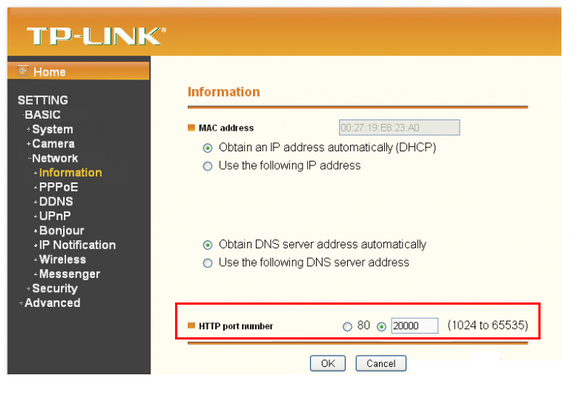
Now connect to the router via the web interface (instructions on how to do this can be found on the Internet) and go to the menu “ Forwarding" (forwarding) - "" (virtual servers). In the address bar enter xx.xx.xx.xxx:20000, Where xx.xx.xx.xxx - your IP address, a:2000 - port value, which you specified (HTTP ports, service port) for the camera and entered into the “Virtual Servers” menu to connect to the router.

As soon as you change the parameter values, you can use a special program for viewing and recording images from a computer via a router. With its help you can get 24/7 camera access.
In order to configure the utility, you must:
- Go to main menu programs “Main console” - “Config” (configuration);
- Go to tab“IP camera and video server settings”;
- Fill in the fields in accordance with the data used above to connect to the router.

Conclusion
As you can see, connecting and setting up the camera correctly is quite simple. At the same time, some nuances must be strictly observed in the process. If you strictly follow the instructions, you will definitely get everything right the first time.
Video on the topic
In order to successfully connect and configure an IP camera using a router and the Internet, minimal knowledge about this device is required. Unlike USB cameras, which are designed for online communication primarily through programs such as Skype, IP cameras are designed with the primary purpose of network broadcasting. It is worth considering the use of these video devices when you need to connect more than one video camera.
All modern devices are gradually equipped with wireless technologies with the ability to broadcast on the Internet. Despite their obvious advantages, they also have their disadvantages, for example, the high cost of the device and, as you move away from the router, the quality of data transmission decreases. Therefore, the device should not be too far from the router.
Among the advantages are the broadcast of ready-made compressed audio and video signals without failures and ease of installation via existing networks, as well as the ability to control the IP camera using any computer on the Internet.
Connection
First, you need to decide on the method of transmitting image and sound and choose from the following two:
- wireless;
- wired.
If you choose the second connection method, you will need to connect the router to the video device via a UTP cable.
An IP set-top box does not mean ordinary equipment connected to a PC, but rather a network participant with its own IP address and settings via a web interface at an individual address.
Settings

How to configure the router?
- For all IP cameras, you must enable the virtual server in the settings window.
- In the case of a permanent IP address, you need to write in the browser: http://address:8181. The first IP camera window will open. If the address is dynamic, then you need to follow the steps described below.
- Open the WAN window and check the “Yes” box for DNS.
- It is necessary to save the entered parameters.
- That's all and you can start watching the video broadcast.
Following the given simple sequence of actions, any user can configure and connect an IP camera via a router.
Conventional surveillance techniques are a thing of the past. Nowadays IP cameras are popular on the market and there is a logical reason for this. Firstly, a device using the Internet protocol broadcasts ready-made digitized content without the slightest brakes or delays. Secondly, ease of use. The cameras are easy to install and use. Also, the equipment can easily connect to a ready-made local or wireless network. Thirdly – price. The price tag for IP cameras is still steep, but this is not a webcam to save on. On average, a modern video surveillance device costs the same money as an archaic analog device. A nice addition will be the fact that it is possible to monitor remotely.
And we will tell you how to set up an IP camera with your own hands in this article. For confident PC users, the adjustment process will not be difficult. For the rest, we have selected and described in detail the simplest method of adjusting the device.
IP and regular camera - is there a difference?
Before answering the logical question of how to set up an IP camera on a computer, let’s look at its differences from a webcam. The latter is an additional gadget connected to a PC. Such devices are used mainly for making calls.
An IP camera has a completely opposite purpose. Such devices are used to monitor an apartment, office or street. An important and, perhaps, the most important difference between such equipment is the fact that the IP camera is a full participant in the network. Accordingly, the device has its own unique address, not similar to others.
There are both wired and wireless cameras on the market. The only difference is the price. For wired devices, you will have to lay a cable, so you should install the gadget before repairing it. If you don’t want to stir up walls and baseboards, you should pay attention to the wireless option.
note
For continuous and correct functioning wireless camera You should place it close to the router.
There are devices on the market different types. IP cameras can be divided into rotating and non-rotating. Advantage PTZ camera the fact that you can remotely move the lens, change the viewing angle, etc. There are also devices used for installation outdoors. They are characterized by increased moisture resistance and can also withstand high temperature loads.
How to connect and configure an IP camera via a router
Modern devices work through a router. This is accomplished using an Ethernet cable. Consider purchasing a more powerful gadget with more inputs if you plan to use multiple cameras.
- Run a special program from the disk. Usually it is placed next to the device itself.
- Download software from the Internet.
- The address is also printed on the device itself or on the instructions supplied with it.
If you decide to check the functionality of the device by following the IP address using an Internet browser, you will not see anything. This is all due to the fact that the stationary unit and the IP camera use different subnets. To get the result, we need to set the address on the device local network.

Open the “Control Panel” and go to the network management tab. In the “Connections” section that appears, you will see the line “Ethernet”. It also sometimes says “Local Area Network Connections”. In the window that appears, select the section with information. In the tab that opens we will see our IP address. It is located in the “IPv4 Address” column. The address of our PC is 192.168.99.183, and the IP camera is 192.168.0.20. For further proper functioning of the device, we will have to replace the third digit in the camera address with the third digit from the address of our local network.
Simply put, from 192.168.0.20 we must make 192.168.99.20. The numbers will vary depending on your provider and the equipment you purchased, so don't be alarmed if you get different numbers.
Replacing the IP address
Exist different ways, how to change the address on a video surveillance device. We chose 2. The first one is the simplest. Suitable for novice users. You will have to dig around with the second one, and we advise using the second method only for people who are confident in their knowledge of a personal computer.
Replacement using the program
The first, and therefore the simplest, method is to convert the IP address of the surveillance camera using an application that you launched from the disk included in the box with the gadget, or downloaded from the Internet.
Each manufacturer has its own applications, but despite this, in any of them you will find an item with a change of address. Next, enter the address and voila, you're done. Taking into account our data, the video will be broadcast at 192.168.99.20. Your local network address will be different, so the output numbers will be different. Our camera now works on the same subnet as the computer. Therefore, you can check its functionality through the browser. Enter the address of your device in your Internet browser. After downloading, you will be able to observe what is happening in front of the lens of your device.
Replacement via software
The second method is that the local network address of your PC will change, not the purchased device. Let's say the address of a personal computer is 192.168.99.25, and the IP of the camera is 192.168.0.20. This means the local network address should change to 192.168.0.25.

To do this, open the “Control Panel” and select Network Management. Let’s follow the line “Ethernet” or “Local Area Network Connections”, but now open the “Properties” window.
In the tab that pops up, click on “Protocol fourth version” and go to properties. In the tab we change the IP to the one we selected, we do not touch the subnet mask, and use the camera address as the main gateway. Then don't forget to apply and save our chosen settings.
To check the functionality, open an Internet browser, go to the device program and enter the IP address of the surveillance camera in the browser. If you did not make any mistakes in the previous steps, a window will appear on your monitor for entering administrator data. You will find them on the device box or in the manual. Manufacturers often use simple combinations. The login is almost always “admin”, and the password is “admin”, “00000” or “12345”. But to be sure, we recommend that you familiarize yourself with the data suitable for your device.
If the data is entered correctly, a window will open in which you will see video from the camera and settings.
In the software of your device, you should compare the device address with that located in the local environment. You will be able to find the appropriate settings in the window called “Network”. Then mark the IP as fixed and enter the following data:
- Address: 192.168.99.20.
- Subnet mask: standard 255.255.255.0.
- Gateway (your router address): 192.168.99.25.
- DNS ip address: 192.168.99.25.
Please indicate your consent next to DCHP. If there is no such line, select the “Dynamic IP” line.
The next step is to assign your camera its own port. From the factory, the cameras have port 80 open. If your device does not have such a setting, we will use this value. If there is a setting, we assign each camera its own unique port. For the first 8081, for the second 8082 and so on.
After following these instructions, disconnect the cable from your computer and plug it into the Ethernet slot of your router. We reset the settings we entered earlier on the computer itself. In the network settings, put consent next to the “Obtain an IP address automatically” column. We repeat the same procedure with the address. DNS servers. We save the settings and connect the router to a laptop or system unit using the built-in network card.
After following the instructions, you will receive a broadcast directly from the IP camera at the specified address. In our case it is 192.168.99.20. Then we adjust Wi-Fi to receive a picture from a mobile phone or tablet. We perform a similar scheme with other gadgets, if available.
Don't forget to give the cameras their unique port (if available) and Internet Protocol address, for example, 192.168.99.20, the next one will be 192.168.99.25. Thus, organize a chain of the following cameras.
How to set up a camera: preparing the router for Internet broadcasting

To do this you need:
- First of all, let's connect the previously adjusted IP cameras to the router using LAN slots or via Wi-Fi.
- We connect the router directly to the PC via a cable.
- Next, go to the router’s software page and begin port forwarding.
The parameters required for adjustment are located in the “Port Forwarding”, “Routing”, “Wide Area Network” tabs or in the “Virtual Server” tab. The device has the following parameters depending on the manufacturer:
- We write the name of the service ourselves, for example, “Camera number one” or “Camera in the kitchen.”
- Port range – here you should specify the number of ports previously assigned by us.
- Local IP address – here you should specify the address of the surveillance device. In our case it is 192.168.99.20.
- Local port – 8081, 8082, etc. If the camera does not have such settings, write 80.
- Protocol – TCP – this is the type of protocol that modern IP cameras work with.
- In the “Protocol number” column, leave all fields empty, or write “1” everywhere.
Using the same example, we configure each device. Be careful, all surveillance devices must have their own address.
To provide access to the surveillance system from any device with Internet access, you need to have a permanent Internet Protocol address. You can buy it from your provider or purchase it from the DynDNS website. This site will be able to give your non-permanent IP address any static domain name, like http://unique_name.ddns.ru.
First, you should enable the permanent Internet Protocol address feature in your router settings. Typically these parameters are located in the “WAN” section in the “DDNS” line. The next step is to register your domain name on the website (ASUS brand routers have a website for operations of this kind, where this is done for free), and write it into the router parameters.
Checking the operation of the CCTV camera

After all the above operations have been completed, you should check the IP camera for functionality. In order to make sure that your surveillance device is active and working properly, open your Internet browser and go to the website http://unique_name.ddns.ru:8081, and if you use your home computer or within a local circle, just go to the Internet address your camera's protocol.
If all the instructions were followed correctly, then after going to the address you will see an image transmitted from your device. When you change the ports (for example, instead of 8081 put 8082) you will get a view from other connected equipment.
We have thoroughly discussed several methods on how to set up a CCTV camera on a computer via a router. Using the instructions proposed in the article, you will not have problems with installing and properly adjusting your gadget. If all points are followed, you will organize a video surveillance network both from home and from a portable device.
IP cameras are the most functional equipment for security systems of any configuration and scale. Their use provides many benefits to an organization or individual:
- High image quality and resistance to interference and other electromagnetic interference;
- The ability to connect to an existing office computer network and the use of wireless Wi-Fi technologies eliminate the need to install an additional network indoors;
- Possibility of connecting to a local power source via network adapter or the use of PoE technology ( Power over Ethernet) 802.3 af, which allows you to supply the necessary voltage through a regular network cable twisted pair
Routers used on the network must support PoE technology to provide power supply to the cameras via the same cable.
There are several ways to organize video surveillance via an IP camera:
- Using a cable connection (directly or through a router) with all information output directly to a local PC, with further processing of the video signal using utilities or programs;
- Using a Wi-Fi router and utilities included with the IP camera or special software that significantly expands the capabilities of administering the video surveillance system;
- Using regular network routers via the global network.
Connecting the camera
Connecting the camera to a PC can be done in two ways:
- Directly - oblique crimping is used (crosswise method of distributing twisted pair wires in an RJ-45 connector);
- Through a router (hub, switch) - a direct type of arrangement of wires in the connector is used.
![]()
A little theory
To gain access to the internal firmware of the camera, regardless of whether through a global or local office network, you must assign a unique name to the device - an IP address. The following types of IP addresses exist:
- White addresses are a unique, inimitable code used on the Internet. It is also called a public (global) address. It can be used to gain access to the network from anywhere in the world, since global addresses are routed by provider servers.
- Gray addresses refer to the organization’s local network and cannot be seen from the outside. There are three classes of gray address subnet:
External IP addresses are conventionally divided into static - fixedly assigned to the equipment and not changing for the entire duration of the contract with the provider, and dynamic - changing over time or after each new login to the network.
You can determine which address the provider provided by connecting the line it laid to the PC using the following network resources:
- _2ip.ru
- _speed-tester.info/ip_location.php
- _smart-ip.net
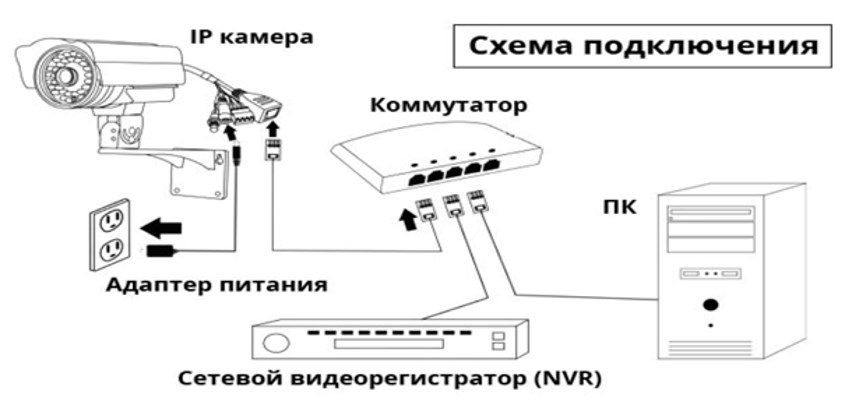
Camera setup via DynamicDNS service
This method is the easiest, but has several conditions for its use. First, the camera itself must support the DynamicDNS service. Secondly, the router must use a dynamic white IP address, which must be ordered from the provider for an additional fee. Then we register a unique DNS domain name on one of the sites that provide similar services, for example:
- _dynru.ru
- _hldns.ru
- _dyn-dns.ru
- _ipnodns.ru
This name is entered in the camera settings in the appropriate fields. After a certain time (depending on the caching settings of the provider), the camera will contact the local router IP address registered in it, the DNS resource and update the current DDNS record settings.
Configuring an IP camera to the Internet directly without a router
This method is supported by many models modern devices. To do this, a cable provided by the provider is connected to the camera via an RJ-45 interface. Through a remote PC, you can log into the camera firmware via the web interface at the address provided by the provider.
To connect, you can only use a white IP address; this setting allows you to use only one camera, which is extremely wasteful, given the cost of the provider’s services.
Connecting multiple IP cameras via a router
If you plan to connect the entire video surveillance system, consisting of several dozen cameras, then in addition to setting up the DDNS domain on the camera and having a white IP address, you must have a router. Configuring the video surveillance system's access to the global network involves the following steps:
- Setting up Internet access;
- Serial connection of IP cameras to it using cables or Wi-Fi connection;
- You need to go to the firmware of each camera in turn and change the port value in the DNS access settings. The current default value of 80 is replaced with any network-unique number between 1000 and 65000.
- Next important stage is “port forwarding” of the router in the corresponding menu item on its firmware. (log in through the web interface using the IP address provided by the provider and assigned to the router earlier).
For many manufacturers and models of routers, the port forwarding procedure is slightly different.
Port forwarding
Traffic is redirected from the incoming port of the router to the ports of network devices using NAT (NAPT) technology; most modern network devices support it.
D-Link
Having entered the router firmware via the web interface, you must press the “Advanced settings” button. From the menu that appears, select the “Firewall” section, and in it “Virtual servers”.
Filling out the template:
- The name is unique, but convenient for identification on the network;
- Protocol – selected from the drop-down menu, usually the most common protocols are PCP/IP 4 or 6;
- External port (start/end) – indicate the port from the information provided by the provider. Usually there is only one, so the final parameter is not filled in;
- Internal port (start/end) – indicates the range selected by the user (from 10000 to 65000).
- The internal and remote IP address of the server is filled in only if the user has a multi-level network using domain names. The fields are usually left blank;
- Changes made to the settings are saved.
Most D-Link routers have ready-made settings templates in their firmware, information from which (range of ports for cameras and DNS name) can be transferred to external devices.
TP-Link
Similar parameters are filled in in the menu item “Forwarding” → “Virtual Servers” → “Add New”.
Fields used:
- Service port – this means an external port;
- Inland port;
- IP address.
ASUS
The fields are filled out in the “Internet” menu, “Port Forwarding” tab; the fields are located at the very bottom of the page:
- Port range – you can specify one, a range separated by commas, or a mixed value;
- Local address – internal address of the camera;
- Local port – internal port of the camera;
- Protocol – connection type, usually PCP/IP 4 or 6.
Conclusion
Access from any external resource to the configured IP camera will look like this:
HTTP:// (white address registered on the router): (unique port number assigned to the video camera.
Thus, you can connect to the camera not only from a PC, but also from a tablet, smartphone or laptop. To do this, you need to install the appropriate software on your device. It is usually provided for free distribution by the camera manufacturer. You can download the program from the company's official website.
For devices running Android OS, you can download the corresponding applications from the Play Market resource, and for Apple gadgets from the Apple Store resource. Naturally, unlike Windows tablets, you have to pay for these programs.
Today, the video surveillance industry is seeing a gradual transition from analog cameras to modern digital IP video capture devices. This fact is quite natural, since analog devices do not keep up with developments at all. modern technologies, when both are offered to the user much best quality images and ease of use of the video surveillance system as a whole for virtually the same amount. Plus, with the help of the latter, it is quite easy to organize remote control of an object, which in our time is also becoming an important point when creating a video surveillance system.
In connection with the widespread transition to IP cameras, more and more people began to be interested in the question of their correct connection and setup. Of course, for a novice user this may seem like a difficult and insoluble task, but for those who have been familiar with computers for a long time, connecting and setting up IP cameras will not cause any particular difficulties. In this article, we tried to describe in as much detail as possible the process of connecting a digital IP camera to a computer, as well as setting the correct settings for the correct operation of the device.
Connecting the IP camera to the computer
Any IP camera connects directly to the computer's network card via. If there are several cameras, then to access the image from each of them you need to connect the IP cameras via a router.
All IP cameras have their own address by default, and before we start setting up the IP camera, we need to know it. To do this, you can use specialized software, which usually comes with devices, or download the necessary utility from the manufacturer’s website. In addition, the IP address of the camera is usually written in the user manual or on the device’s label.
If you try to access the camera interface through a browser the first time you connect, you will probably fail. This happens because the computer and the camera are configured to work on different subnets. After we have found out the IP address of the camera, we need to bring it into line with the one used on your local network.
Today, the creation of remote video surveillance is especially important. Surveillance via the Internet is quite easy to carry out using a router with a dedicated IP address. Online video surveillance can be implemented in 4 ways, which you can read about.
Create remote video surveillance is becoming more accessible with the help of special ones. Moreover, when implementing cloud video surveillance you do not need a dedicated IP address, and equipment settings are kept to a minimum.
For video surveillance at remote sites, GSM cameras may be useful to you. They will be convenient to use in the country house, garage, or country house, because they can promptly warn you about the occurrence of various extraordinary events at the facility by sending a message to your mobile phone. You can read about GSM cameras for video surveillance using this link.
To find out the IP of the local network, you need to go to the “Sharing and Network Control Center”, then in the “Connections” line, select “Ethernet” or “Via Local Network”. In the window that opens, click on the “Details” button, then a new tab opens, where we find out the IP address of the local network - look at the line “Default gateway IPv4”, in our case the computer works on the network 192.168.99.*. Let's say the IP address of your camera was something like this: 192.168.0.24, now our task is to replace it with 192.168.99.24 - for you it can be any other numbers, but the principle remains the same.
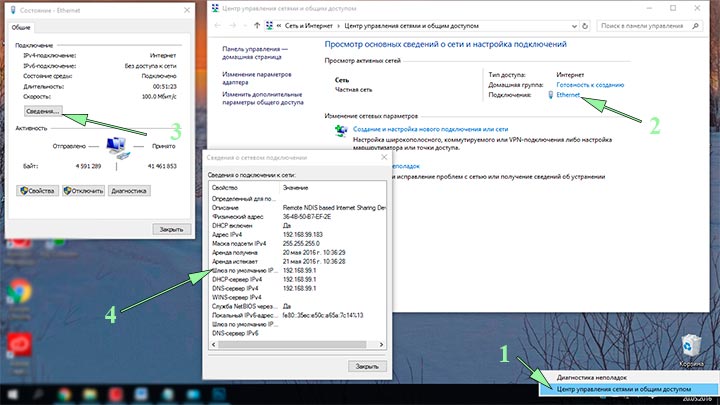
Find out the IP address of the local network
You can change the IP address of the camera using the same program through which you found it out. Hikvision, for example, calls it SADP; other cameras come with their own programs. After the IP address of the camera is brought into line with the address of the local network, the image from it will become available at the new IP address, in our case it is http://192.168.99.24.
Changing the camera's IP address via its web interface
There is another way to get into the camera’s web interface, which involves changing the IP address of the local network. For example, the IP address of our camera is 192.168.0.24, and the local network of the computer is 192.168.99.22, but we need the computer and the camera to work in the same subnet (.99. or.0.). To do this, let’s bring the local network subnet in line with the camera address, for example, change it to 192.168.0.22. To do this, go to the “Sharing and Network Center”, then in the “Connections” line, select the “Ethernet” or “Via Local Network” item. A window should appear, as in the screenshot below. In this window, click on the “Properties” button, then select “IP Protocol version 4 IPv4”, call up its properties, and manually enter the IP address 192.168.0.22, and specify the address of our IP camera 192.168.0.24 as the gateway. Don't forget to save the settings.

Registering an IP address to access the camera. The picture is available for enlargement
Now, through any browser, go to the device’s web interface - enter the camera address 192.168.0.24 in the search bar. If you did everything correctly, a window should open to enter your username and password, which we take from the camera instructions. Usually by default they are admin/admin, admin/12345, admin/00000000, and other easy combinations. After entering the data, you will be able to view the image from the camera, as well as configure the camera.
In the camera's web interface, you need to match the camera's IP address with the local network address. Typically these settings are located on a tab called “Network”. For example, your router is located at the local network address 192.168.99.22, which means that for the camera we need to set an IP something like this: 192.168.99.24. We put a tick in the IP settings for “Fixed IP address” - we will need it to configure it, and enter the data:
- IP address: 192.168.99.24;
- Subnet mask: standard 255.255.255.0;
- Gateway (IP address where our router is located): 192.168.99.22;
- DNS IP Address: 192.168.99.22.
If you do not want to view your cameras via the Internet, then simply check the box next to the Dynamic IP (DCHP) line.
Now you need to assign a port to your camera. By default, port “80” is open, so if your camera does not have such settings, you must use it. If this line is available, we enter the values manually for each camera. For the first, for example, we will set port 8081.
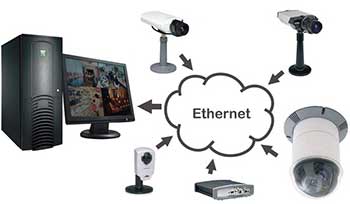
Scheme for connecting IP cameras to a computer via a router and creating access via the Internet
Save the settings, disconnect the camera’s network cable from the computer and insert it into a free port on the router. After this, we reset all the manual IP address settings that we made earlier on the local network to connect to the camera’s web interface to automatic - we simply check the dots for obtaining the IP address and DNS addresses automatically, and connect the router to network card computer. If necessary, log into the camera’s web interface through the router using the IP address assigned to it ( http://192.168.99.24), and set up a wireless connection via Wi-Fi. We make the same settings for each camera, and do not forget to assign different IP addresses and ports to all other devices, if this is permissible (on some cameras there is no provision for manually setting ports, for them it will be standard - “80”). For example, we will assign IP 192.168.99.25 to the second camera and port 8082, the third 192.168.99.26/8083, the fourth 192.168.99.27/8084, and so on.
For video surveillance using IP cameras via a computer, you may need special programs. They can be included with the equipment or downloaded separately from the Internet. You can read about them at.
In some cases, it is more appropriate to use IP cameras instead of IP cameras. For example, when a video surveillance system consists of only one camera.
You can organize video surveillance at your dacha using a regular 3G router and several IP cameras. At the same time, it is very important that there are no interruptions in the cellular network signal in your area. Read the article about how to implement country video surveillance using this method.
Setting up a router to view IP cameras via the Internet
After setting up the cameras, it’s the router’s turn:- We connect all configured cameras to the router via LAN network ports, or via Wi-Fi;
- We connect the router to the computer via Wi-Fi or a network cable;
- We go to its web interface and begin port forwarding so that the router, when accessing a specific address from the outside, knows which camera to issue from the internal network.
These settings can be located in sections called “Port Forwarding”, “Routing”, “WAN”, in the “Virtual Server” or “Virtual Server” tab. First, you need to check the box to activate the virtual server. Depending on the router model, you may come across similar settings:
- Service name - enter manually, for example, “First camera”;
- Port range - the port that we assigned in the settings of the first camera (8081);
- Local IP address (IP camera address) - for example, we have it 192.168.99.24;
- Local port - 8081, or 80 if the camera does not have port settings;
- Protocol: TCP – the IP camera works with this protocol;
- Protocol number: leave the field empty, or write any number, for example, 1.
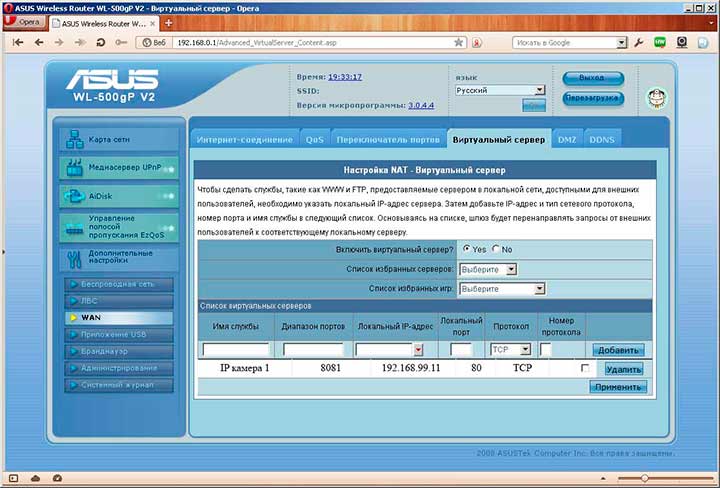
Connecting and setting up an IP camera via a router
We prescribe the settings for each camera according to the above principle. Do not forget that each camera must have its own different IP address and port, if, of course, there is such a possibility.
To be able to connect to the cameras from any device with Internet access, you will need a static IP address. You can order it from your provider for a fee, or use the DynDNS service. Using this service, you can assign any domain name to your dynamic IP address, like http://your_unique_domain.ddns.ru. But first you need to activate this function in the router settings. In some routers, these settings are located in the “WAN” section on the “DDNS” tab. There you can specify the server (DynDNS, ASUS, NO-IP, etc.), your 3rd level domain name, and other necessary settings. Next, we register the domain name on the service (by the way, ASUS routers have their own free service for these needs), and register it in the router settings.
Checking functionality after setting up IP cameras
After setting up the IP cameras and router, let’s check their functionality. To do this, you need to open your browser and write the IP address of the camera and its port in the address bar in the following form: http://your_unique_domain.ddns.ru:8081, or http://your_static_IP_address:8081. When accessing the camera from your computer located on the same local network as the camera with a router, simply enter its unique IP address into the address bar.
If you have configured everything correctly, the system should work, and when you enter different ports in the address bar of the browser, you will see a picture from the corresponding camera.
So, we have looked at the question of how to connect an IP camera to a computer and configure it to work on a local network, as well as organize access to it via the Internet from any device. Remember that some nuances on the equipment different manufacturers may vary, but the basic setup principle will always be the same.
Did you like the article? Share with friends on social networks!